Analysis of Communication Skills in Business: A Report
VerifiedAdded on 2020/10/22
|11
|2604
|122
Report
AI Summary
This report delves into the critical role of communication skills within a business environment. It begins with an introduction emphasizing the importance of effective information transfer through various means, including verbal, written, and non-verbal methods. The report then explores communication theories and models, such as Shannon and Weaver's information theory model and modern communication models, highlighting their significance in conveying messages and providing feedback. Furthermore, it examines different communication systems used in businesses, including optical, radio, and duplex systems. The report also covers communication methods, like written, verbal, non-verbal, and visual communication, along with formal and informal communication channels. Practical applications are demonstrated through role plays, letters, CVs, and email examples. Finally, the report addresses the principles of effective communication, barriers, and the use of technology in business communication, offering a comprehensive overview of how to improve and implement successful communication strategies.
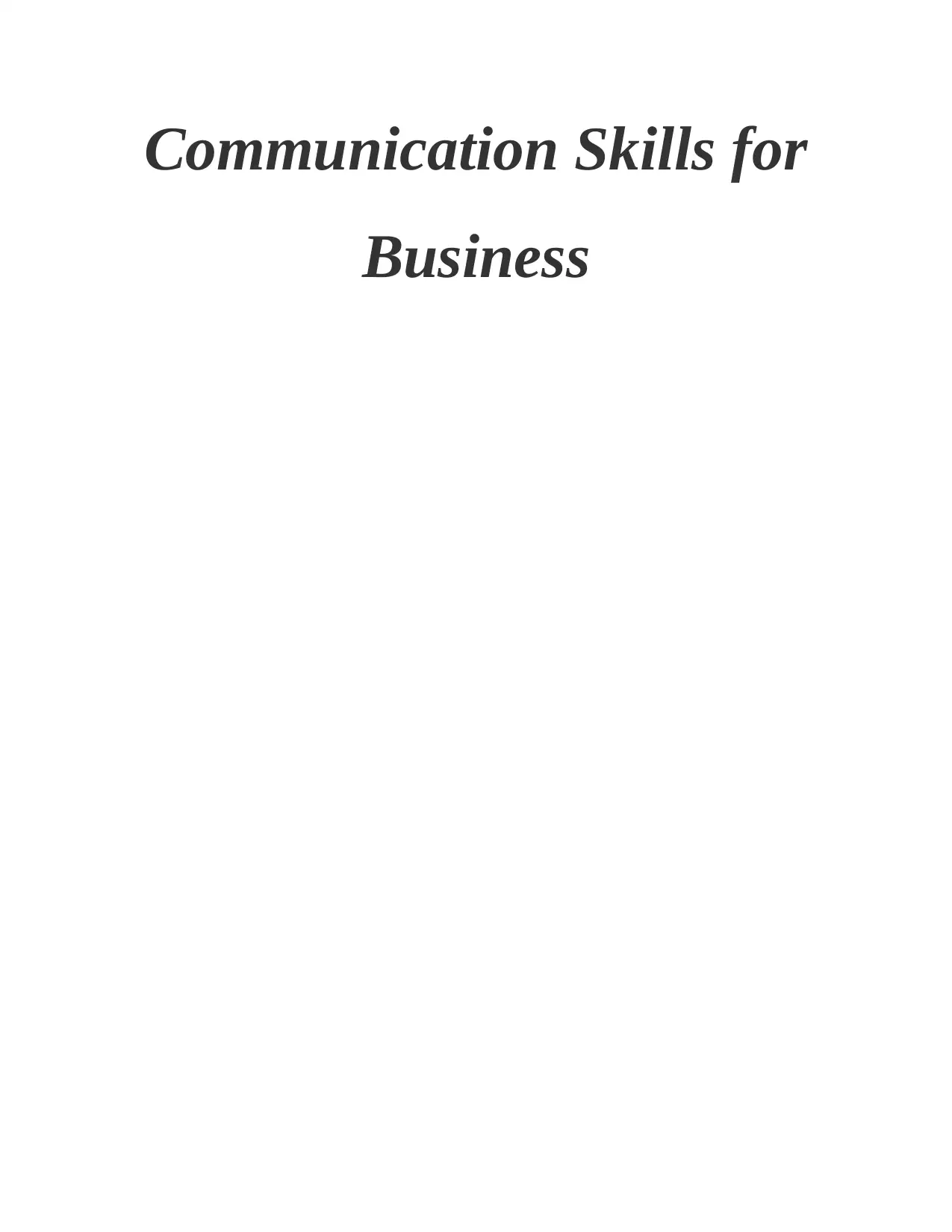
Communication Skills for
Business
Business
Paraphrase This Document
Need a fresh take? Get an instant paraphrase of this document with our AI Paraphraser
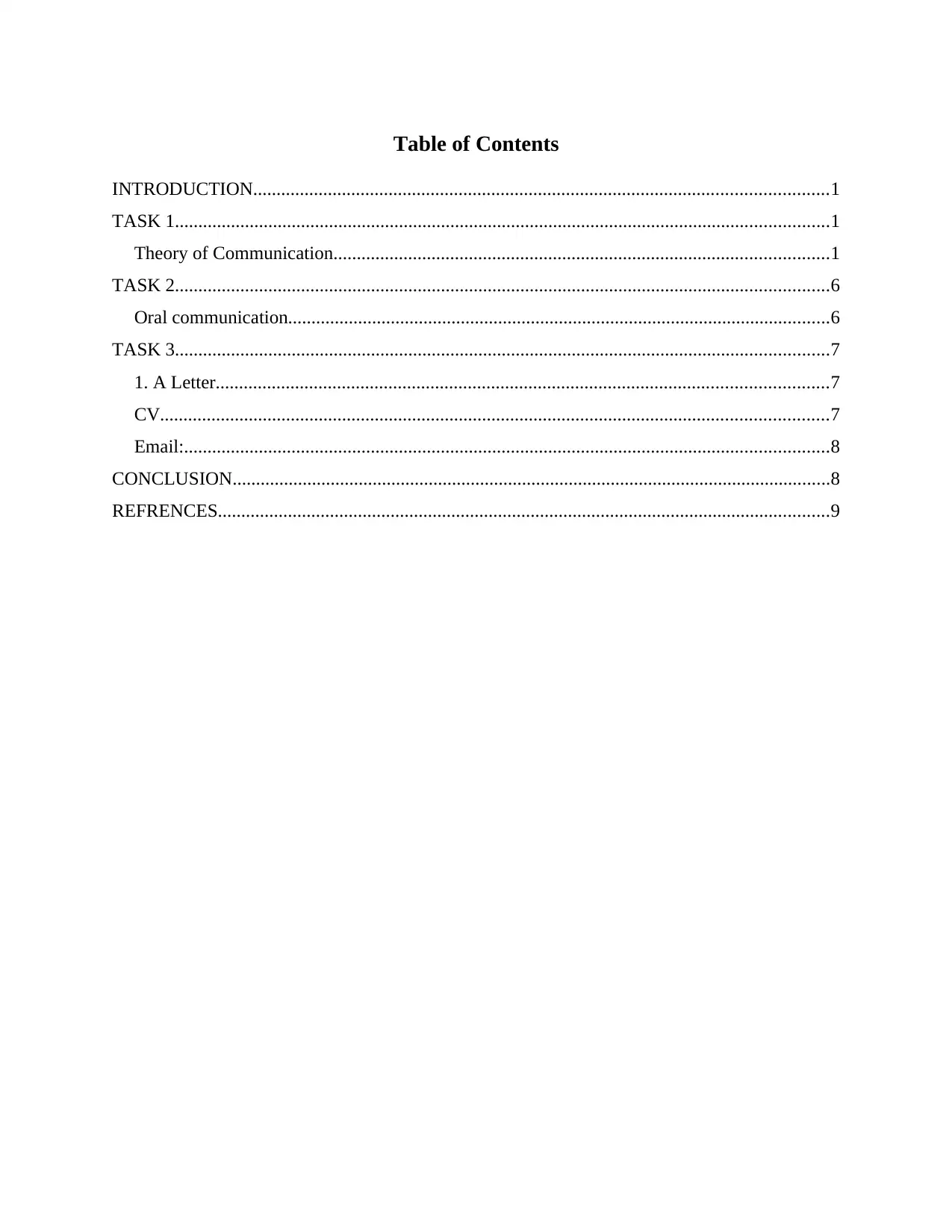
Table of Contents
INTRODUCTION...........................................................................................................................1
TASK 1............................................................................................................................................1
Theory of Communication..........................................................................................................1
TASK 2............................................................................................................................................6
Oral communication....................................................................................................................6
TASK 3............................................................................................................................................7
1. A Letter...................................................................................................................................7
CV...............................................................................................................................................7
Email:..........................................................................................................................................8
CONCLUSION................................................................................................................................8
REFRENCES...................................................................................................................................9
INTRODUCTION...........................................................................................................................1
TASK 1............................................................................................................................................1
Theory of Communication..........................................................................................................1
TASK 2............................................................................................................................................6
Oral communication....................................................................................................................6
TASK 3............................................................................................................................................7
1. A Letter...................................................................................................................................7
CV...............................................................................................................................................7
Email:..........................................................................................................................................8
CONCLUSION................................................................................................................................8
REFRENCES...................................................................................................................................9
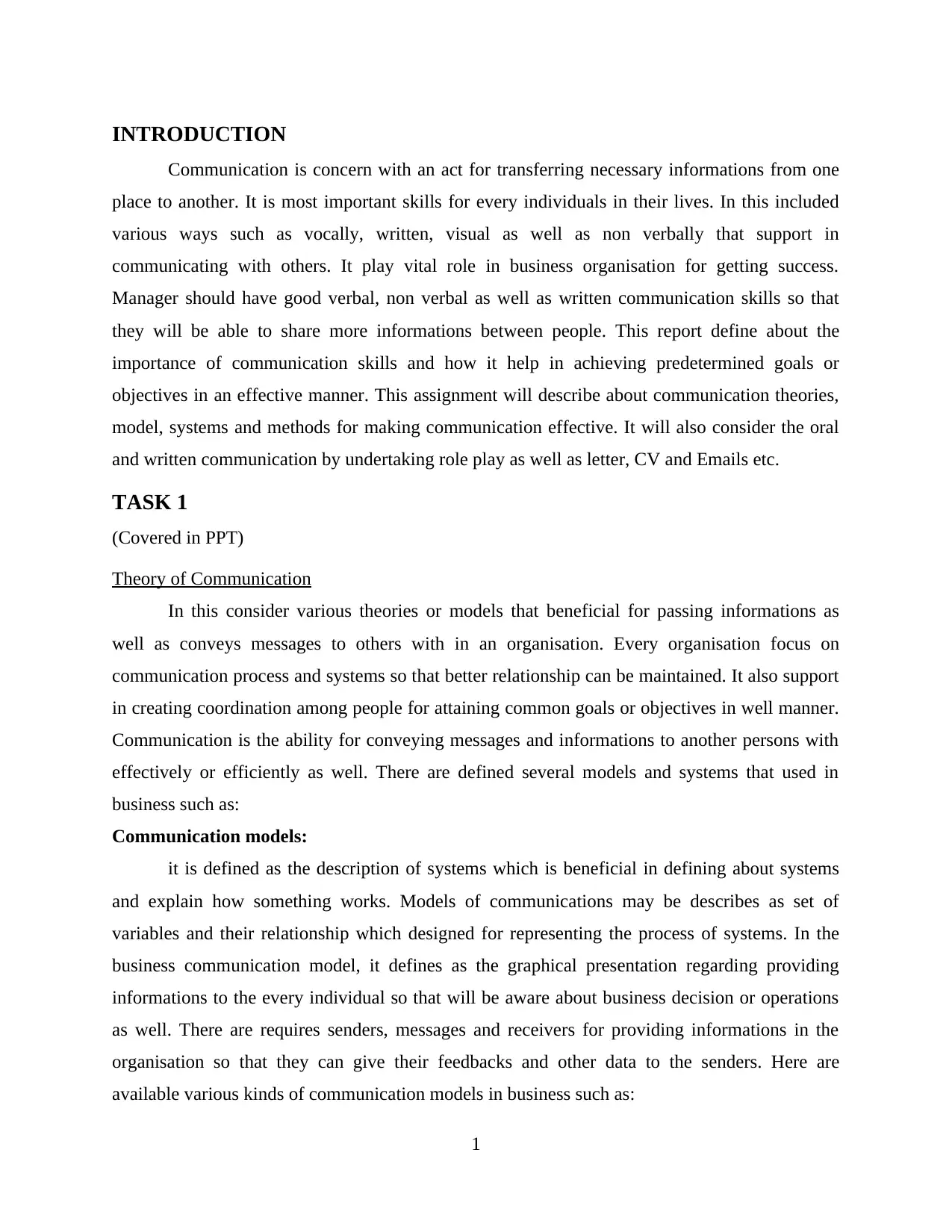
INTRODUCTION
Communication is concern with an act for transferring necessary informations from one
place to another. It is most important skills for every individuals in their lives. In this included
various ways such as vocally, written, visual as well as non verbally that support in
communicating with others. It play vital role in business organisation for getting success.
Manager should have good verbal, non verbal as well as written communication skills so that
they will be able to share more informations between people. This report define about the
importance of communication skills and how it help in achieving predetermined goals or
objectives in an effective manner. This assignment will describe about communication theories,
model, systems and methods for making communication effective. It will also consider the oral
and written communication by undertaking role play as well as letter, CV and Emails etc.
TASK 1
(Covered in PPT)
Theory of Communication
In this consider various theories or models that beneficial for passing informations as
well as conveys messages to others with in an organisation. Every organisation focus on
communication process and systems so that better relationship can be maintained. It also support
in creating coordination among people for attaining common goals or objectives in well manner.
Communication is the ability for conveying messages and informations to another persons with
effectively or efficiently as well. There are defined several models and systems that used in
business such as:
Communication models:
it is defined as the description of systems which is beneficial in defining about systems
and explain how something works. Models of communications may be describes as set of
variables and their relationship which designed for representing the process of systems. In the
business communication model, it defines as the graphical presentation regarding providing
informations to the every individual so that will be aware about business decision or operations
as well. There are requires senders, messages and receivers for providing informations in the
organisation so that they can give their feedbacks and other data to the senders. Here are
available various kinds of communication models in business such as:
1
Communication is concern with an act for transferring necessary informations from one
place to another. It is most important skills for every individuals in their lives. In this included
various ways such as vocally, written, visual as well as non verbally that support in
communicating with others. It play vital role in business organisation for getting success.
Manager should have good verbal, non verbal as well as written communication skills so that
they will be able to share more informations between people. This report define about the
importance of communication skills and how it help in achieving predetermined goals or
objectives in an effective manner. This assignment will describe about communication theories,
model, systems and methods for making communication effective. It will also consider the oral
and written communication by undertaking role play as well as letter, CV and Emails etc.
TASK 1
(Covered in PPT)
Theory of Communication
In this consider various theories or models that beneficial for passing informations as
well as conveys messages to others with in an organisation. Every organisation focus on
communication process and systems so that better relationship can be maintained. It also support
in creating coordination among people for attaining common goals or objectives in well manner.
Communication is the ability for conveying messages and informations to another persons with
effectively or efficiently as well. There are defined several models and systems that used in
business such as:
Communication models:
it is defined as the description of systems which is beneficial in defining about systems
and explain how something works. Models of communications may be describes as set of
variables and their relationship which designed for representing the process of systems. In the
business communication model, it defines as the graphical presentation regarding providing
informations to the every individual so that will be aware about business decision or operations
as well. There are requires senders, messages and receivers for providing informations in the
organisation so that they can give their feedbacks and other data to the senders. Here are
available various kinds of communication models in business such as:
1
⊘ This is a preview!⊘
Do you want full access?
Subscribe today to unlock all pages.

Trusted by 1+ million students worldwide
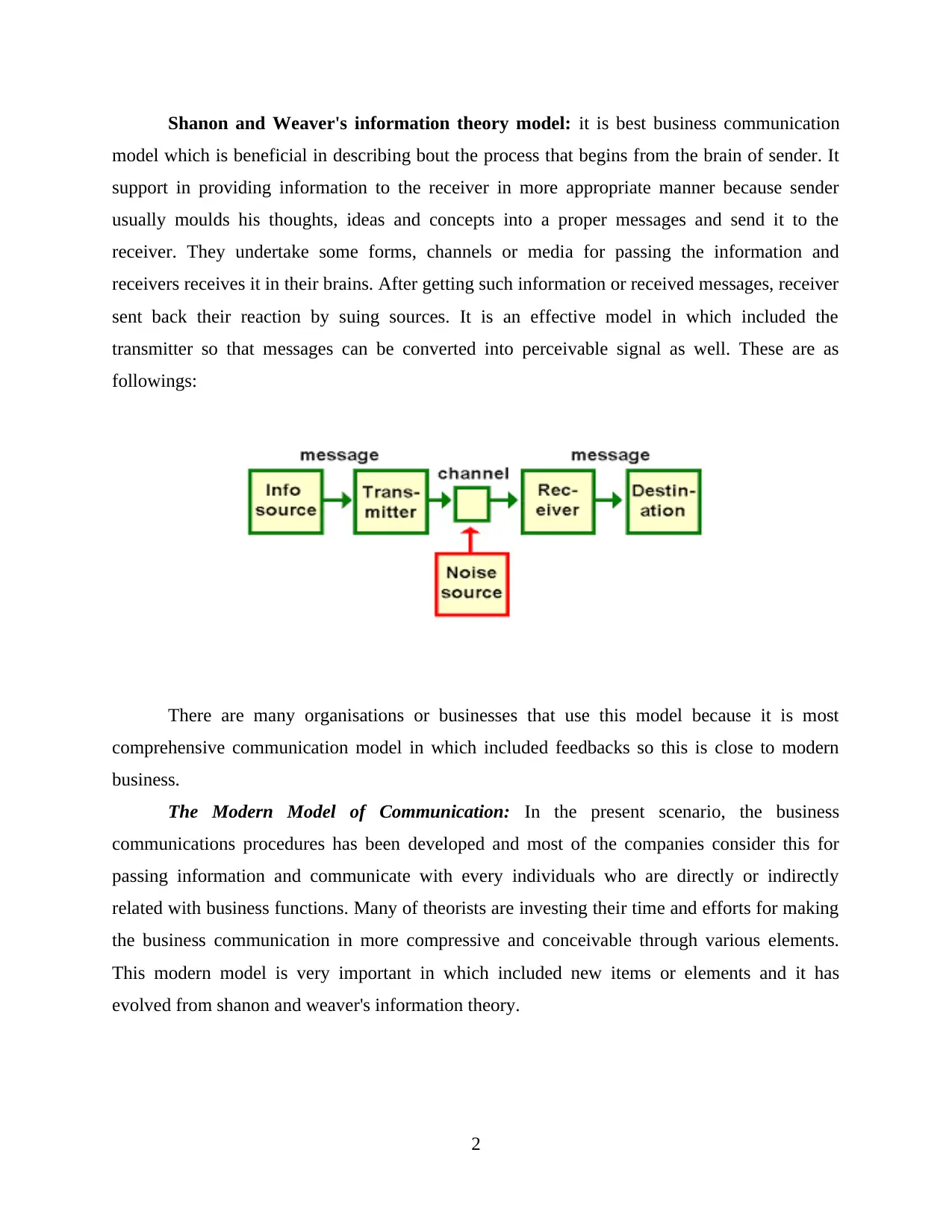
Shanon and Weaver's information theory model: it is best business communication
model which is beneficial in describing bout the process that begins from the brain of sender. It
support in providing information to the receiver in more appropriate manner because sender
usually moulds his thoughts, ideas and concepts into a proper messages and send it to the
receiver. They undertake some forms, channels or media for passing the information and
receivers receives it in their brains. After getting such information or received messages, receiver
sent back their reaction by suing sources. It is an effective model in which included the
transmitter so that messages can be converted into perceivable signal as well. These are as
followings:
There are many organisations or businesses that use this model because it is most
comprehensive communication model in which included feedbacks so this is close to modern
business.
The Modern Model of Communication: In the present scenario, the business
communications procedures has been developed and most of the companies consider this for
passing information and communicate with every individuals who are directly or indirectly
related with business functions. Many of theorists are investing their time and efforts for making
the business communication in more compressive and conceivable through various elements.
This modern model is very important in which included new items or elements and it has
evolved from shanon and weaver's information theory.
2
model which is beneficial in describing bout the process that begins from the brain of sender. It
support in providing information to the receiver in more appropriate manner because sender
usually moulds his thoughts, ideas and concepts into a proper messages and send it to the
receiver. They undertake some forms, channels or media for passing the information and
receivers receives it in their brains. After getting such information or received messages, receiver
sent back their reaction by suing sources. It is an effective model in which included the
transmitter so that messages can be converted into perceivable signal as well. These are as
followings:
There are many organisations or businesses that use this model because it is most
comprehensive communication model in which included feedbacks so this is close to modern
business.
The Modern Model of Communication: In the present scenario, the business
communications procedures has been developed and most of the companies consider this for
passing information and communicate with every individuals who are directly or indirectly
related with business functions. Many of theorists are investing their time and efforts for making
the business communication in more compressive and conceivable through various elements.
This modern model is very important in which included new items or elements and it has
evolved from shanon and weaver's information theory.
2
Paraphrase This Document
Need a fresh take? Get an instant paraphrase of this document with our AI Paraphraser
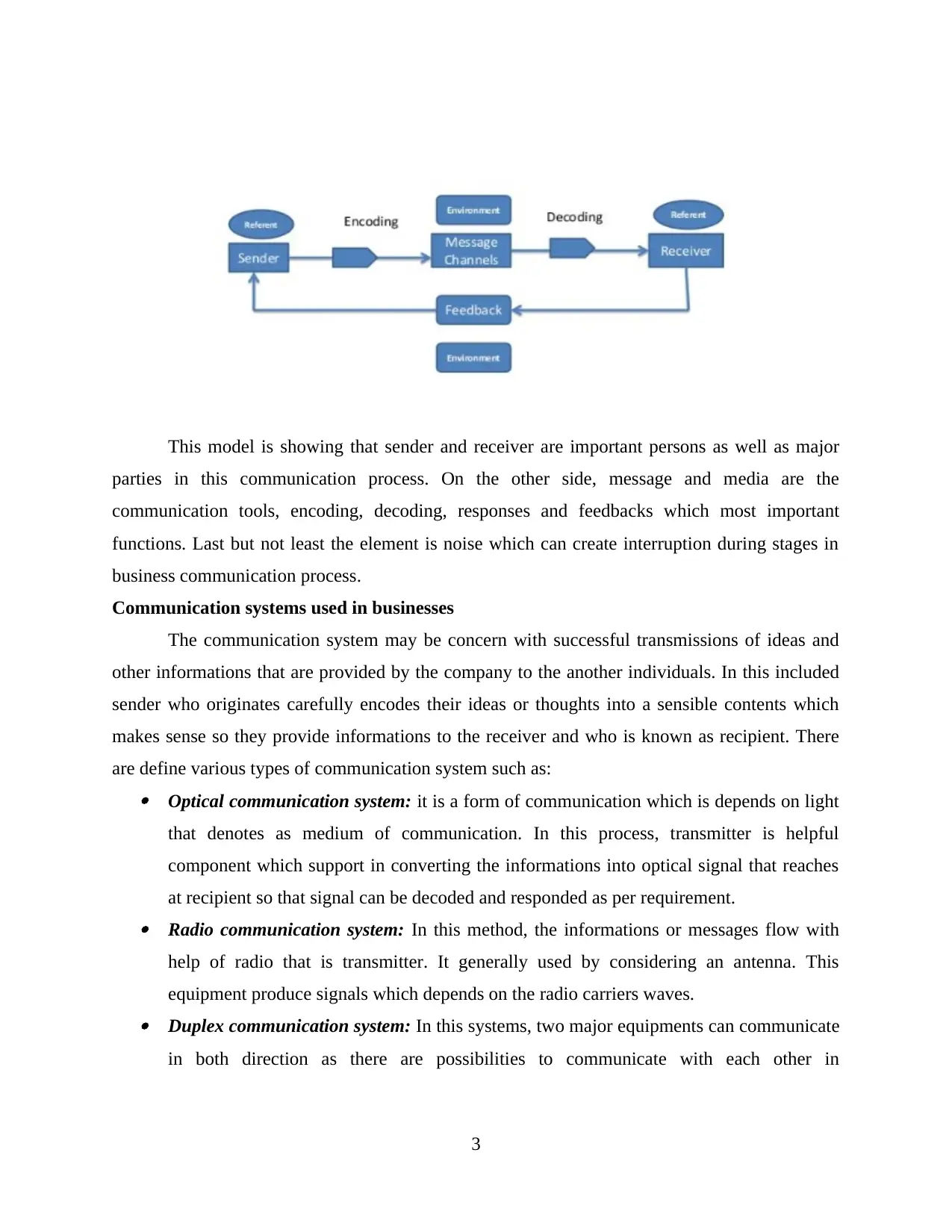
This model is showing that sender and receiver are important persons as well as major
parties in this communication process. On the other side, message and media are the
communication tools, encoding, decoding, responses and feedbacks which most important
functions. Last but not least the element is noise which can create interruption during stages in
business communication process.
Communication systems used in businesses
The communication system may be concern with successful transmissions of ideas and
other informations that are provided by the company to the another individuals. In this included
sender who originates carefully encodes their ideas or thoughts into a sensible contents which
makes sense so they provide informations to the receiver and who is known as recipient. There
are define various types of communication system such as: Optical communication system: it is a form of communication which is depends on light
that denotes as medium of communication. In this process, transmitter is helpful
component which support in converting the informations into optical signal that reaches
at recipient so that signal can be decoded and responded as per requirement. Radio communication system: In this method, the informations or messages flow with
help of radio that is transmitter. It generally used by considering an antenna. This
equipment produce signals which depends on the radio carriers waves. Duplex communication system: In this systems, two major equipments can communicate
in both direction as there are possibilities to communicate with each other in
3
parties in this communication process. On the other side, message and media are the
communication tools, encoding, decoding, responses and feedbacks which most important
functions. Last but not least the element is noise which can create interruption during stages in
business communication process.
Communication systems used in businesses
The communication system may be concern with successful transmissions of ideas and
other informations that are provided by the company to the another individuals. In this included
sender who originates carefully encodes their ideas or thoughts into a sensible contents which
makes sense so they provide informations to the receiver and who is known as recipient. There
are define various types of communication system such as: Optical communication system: it is a form of communication which is depends on light
that denotes as medium of communication. In this process, transmitter is helpful
component which support in converting the informations into optical signal that reaches
at recipient so that signal can be decoded and responded as per requirement. Radio communication system: In this method, the informations or messages flow with
help of radio that is transmitter. It generally used by considering an antenna. This
equipment produce signals which depends on the radio carriers waves. Duplex communication system: In this systems, two major equipments can communicate
in both direction as there are possibilities to communicate with each other in
3
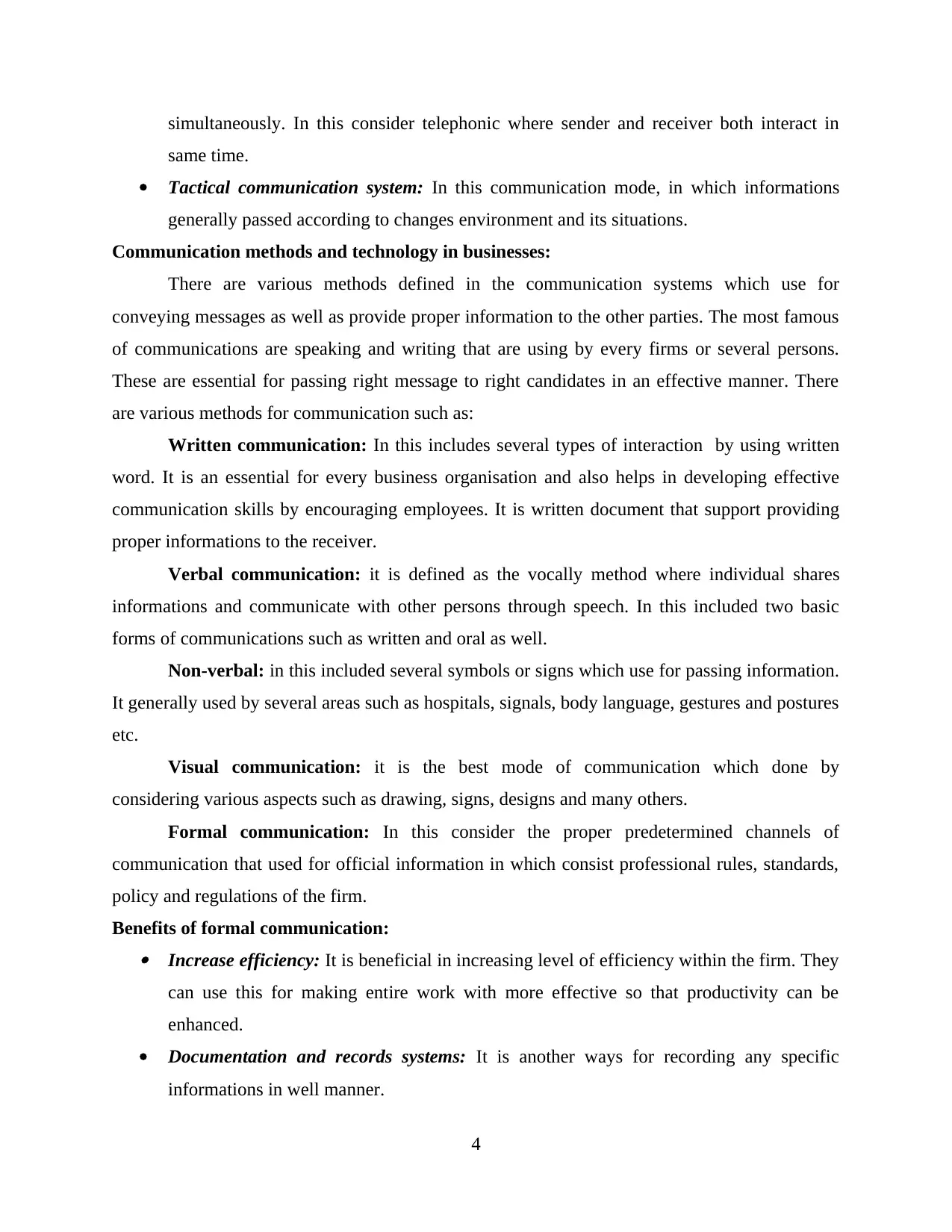
simultaneously. In this consider telephonic where sender and receiver both interact in
same time.
Tactical communication system: In this communication mode, in which informations
generally passed according to changes environment and its situations.
Communication methods and technology in businesses:
There are various methods defined in the communication systems which use for
conveying messages as well as provide proper information to the other parties. The most famous
of communications are speaking and writing that are using by every firms or several persons.
These are essential for passing right message to right candidates in an effective manner. There
are various methods for communication such as:
Written communication: In this includes several types of interaction by using written
word. It is an essential for every business organisation and also helps in developing effective
communication skills by encouraging employees. It is written document that support providing
proper informations to the receiver.
Verbal communication: it is defined as the vocally method where individual shares
informations and communicate with other persons through speech. In this included two basic
forms of communications such as written and oral as well.
Non-verbal: in this included several symbols or signs which use for passing information.
It generally used by several areas such as hospitals, signals, body language, gestures and postures
etc.
Visual communication: it is the best mode of communication which done by
considering various aspects such as drawing, signs, designs and many others.
Formal communication: In this consider the proper predetermined channels of
communication that used for official information in which consist professional rules, standards,
policy and regulations of the firm.
Benefits of formal communication: Increase efficiency: It is beneficial in increasing level of efficiency within the firm. They
can use this for making entire work with more effective so that productivity can be
enhanced.
Documentation and records systems: It is another ways for recording any specific
informations in well manner.
4
same time.
Tactical communication system: In this communication mode, in which informations
generally passed according to changes environment and its situations.
Communication methods and technology in businesses:
There are various methods defined in the communication systems which use for
conveying messages as well as provide proper information to the other parties. The most famous
of communications are speaking and writing that are using by every firms or several persons.
These are essential for passing right message to right candidates in an effective manner. There
are various methods for communication such as:
Written communication: In this includes several types of interaction by using written
word. It is an essential for every business organisation and also helps in developing effective
communication skills by encouraging employees. It is written document that support providing
proper informations to the receiver.
Verbal communication: it is defined as the vocally method where individual shares
informations and communicate with other persons through speech. In this included two basic
forms of communications such as written and oral as well.
Non-verbal: in this included several symbols or signs which use for passing information.
It generally used by several areas such as hospitals, signals, body language, gestures and postures
etc.
Visual communication: it is the best mode of communication which done by
considering various aspects such as drawing, signs, designs and many others.
Formal communication: In this consider the proper predetermined channels of
communication that used for official information in which consist professional rules, standards,
policy and regulations of the firm.
Benefits of formal communication: Increase efficiency: It is beneficial in increasing level of efficiency within the firm. They
can use this for making entire work with more effective so that productivity can be
enhanced.
Documentation and records systems: It is another ways for recording any specific
informations in well manner.
4
⊘ This is a preview!⊘
Do you want full access?
Subscribe today to unlock all pages.

Trusted by 1+ million students worldwide
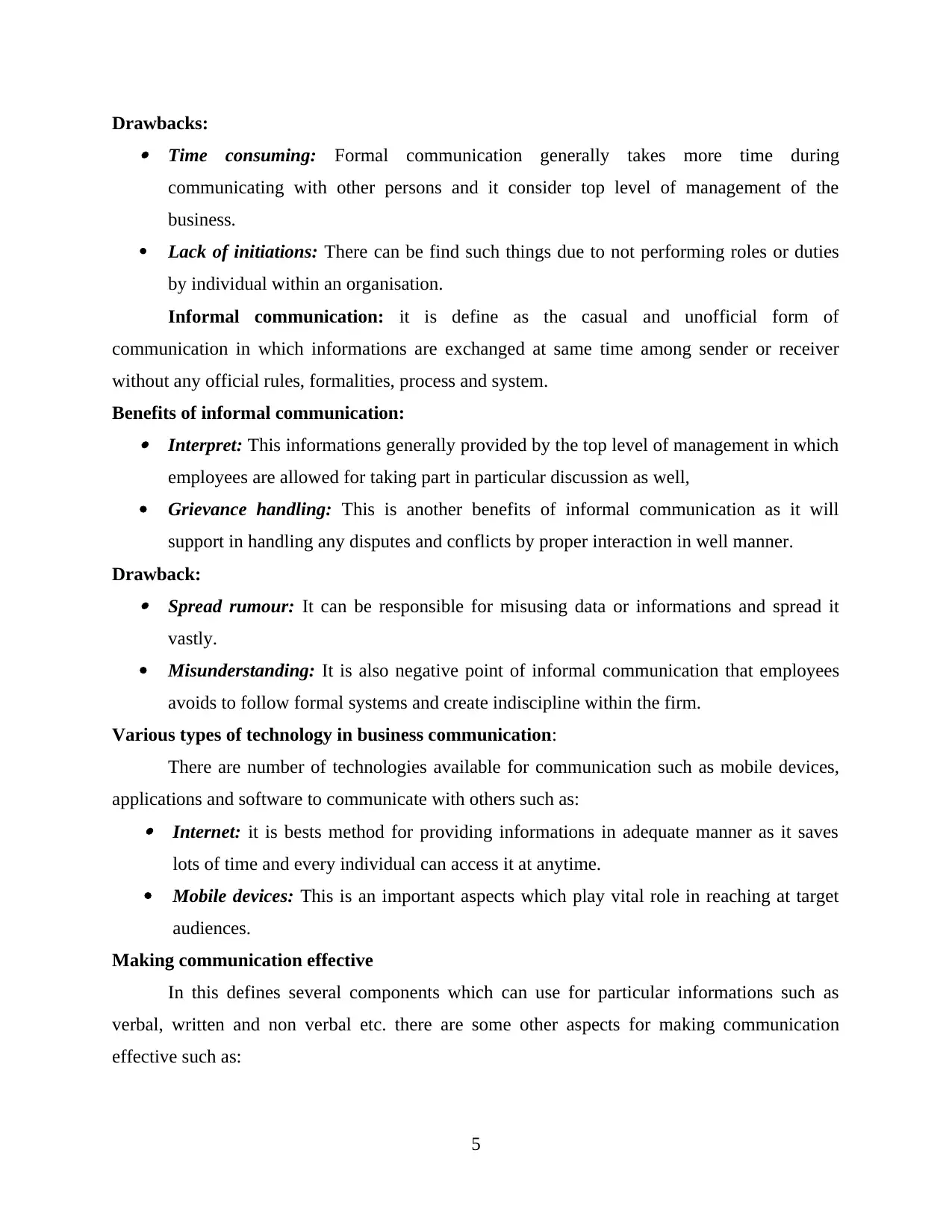
Drawbacks: Time consuming: Formal communication generally takes more time during
communicating with other persons and it consider top level of management of the
business.
Lack of initiations: There can be find such things due to not performing roles or duties
by individual within an organisation.
Informal communication: it is define as the casual and unofficial form of
communication in which informations are exchanged at same time among sender or receiver
without any official rules, formalities, process and system.
Benefits of informal communication: Interpret: This informations generally provided by the top level of management in which
employees are allowed for taking part in particular discussion as well,
Grievance handling: This is another benefits of informal communication as it will
support in handling any disputes and conflicts by proper interaction in well manner.
Drawback: Spread rumour: It can be responsible for misusing data or informations and spread it
vastly.
Misunderstanding: It is also negative point of informal communication that employees
avoids to follow formal systems and create indiscipline within the firm.
Various types of technology in business communication:
There are number of technologies available for communication such as mobile devices,
applications and software to communicate with others such as: Internet: it is bests method for providing informations in adequate manner as it saves
lots of time and every individual can access it at anytime.
Mobile devices: This is an important aspects which play vital role in reaching at target
audiences.
Making communication effective
In this defines several components which can use for particular informations such as
verbal, written and non verbal etc. there are some other aspects for making communication
effective such as:
5
communicating with other persons and it consider top level of management of the
business.
Lack of initiations: There can be find such things due to not performing roles or duties
by individual within an organisation.
Informal communication: it is define as the casual and unofficial form of
communication in which informations are exchanged at same time among sender or receiver
without any official rules, formalities, process and system.
Benefits of informal communication: Interpret: This informations generally provided by the top level of management in which
employees are allowed for taking part in particular discussion as well,
Grievance handling: This is another benefits of informal communication as it will
support in handling any disputes and conflicts by proper interaction in well manner.
Drawback: Spread rumour: It can be responsible for misusing data or informations and spread it
vastly.
Misunderstanding: It is also negative point of informal communication that employees
avoids to follow formal systems and create indiscipline within the firm.
Various types of technology in business communication:
There are number of technologies available for communication such as mobile devices,
applications and software to communicate with others such as: Internet: it is bests method for providing informations in adequate manner as it saves
lots of time and every individual can access it at anytime.
Mobile devices: This is an important aspects which play vital role in reaching at target
audiences.
Making communication effective
In this defines several components which can use for particular informations such as
verbal, written and non verbal etc. there are some other aspects for making communication
effective such as:
5
Paraphrase This Document
Need a fresh take? Get an instant paraphrase of this document with our AI Paraphraser
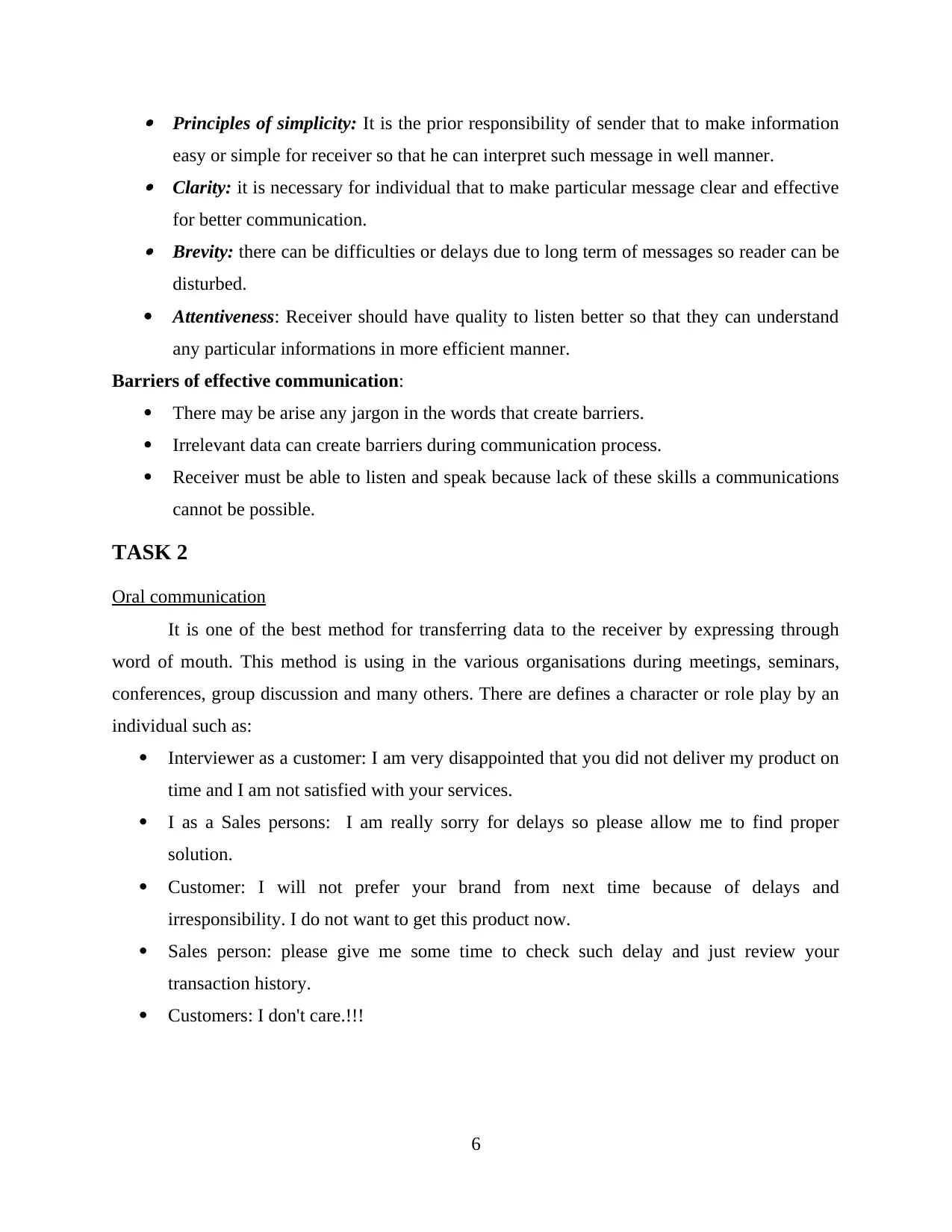
Principles of simplicity: It is the prior responsibility of sender that to make information
easy or simple for receiver so that he can interpret such message in well manner. Clarity: it is necessary for individual that to make particular message clear and effective
for better communication. Brevity: there can be difficulties or delays due to long term of messages so reader can be
disturbed.
Attentiveness: Receiver should have quality to listen better so that they can understand
any particular informations in more efficient manner.
Barriers of effective communication:
There may be arise any jargon in the words that create barriers.
Irrelevant data can create barriers during communication process.
Receiver must be able to listen and speak because lack of these skills a communications
cannot be possible.
TASK 2
Oral communication
It is one of the best method for transferring data to the receiver by expressing through
word of mouth. This method is using in the various organisations during meetings, seminars,
conferences, group discussion and many others. There are defines a character or role play by an
individual such as:
Interviewer as a customer: I am very disappointed that you did not deliver my product on
time and I am not satisfied with your services.
I as a Sales persons: I am really sorry for delays so please allow me to find proper
solution.
Customer: I will not prefer your brand from next time because of delays and
irresponsibility. I do not want to get this product now.
Sales person: please give me some time to check such delay and just review your
transaction history.
Customers: I don't care.!!!
6
easy or simple for receiver so that he can interpret such message in well manner. Clarity: it is necessary for individual that to make particular message clear and effective
for better communication. Brevity: there can be difficulties or delays due to long term of messages so reader can be
disturbed.
Attentiveness: Receiver should have quality to listen better so that they can understand
any particular informations in more efficient manner.
Barriers of effective communication:
There may be arise any jargon in the words that create barriers.
Irrelevant data can create barriers during communication process.
Receiver must be able to listen and speak because lack of these skills a communications
cannot be possible.
TASK 2
Oral communication
It is one of the best method for transferring data to the receiver by expressing through
word of mouth. This method is using in the various organisations during meetings, seminars,
conferences, group discussion and many others. There are defines a character or role play by an
individual such as:
Interviewer as a customer: I am very disappointed that you did not deliver my product on
time and I am not satisfied with your services.
I as a Sales persons: I am really sorry for delays so please allow me to find proper
solution.
Customer: I will not prefer your brand from next time because of delays and
irresponsibility. I do not want to get this product now.
Sales person: please give me some time to check such delay and just review your
transaction history.
Customers: I don't care.!!!
6
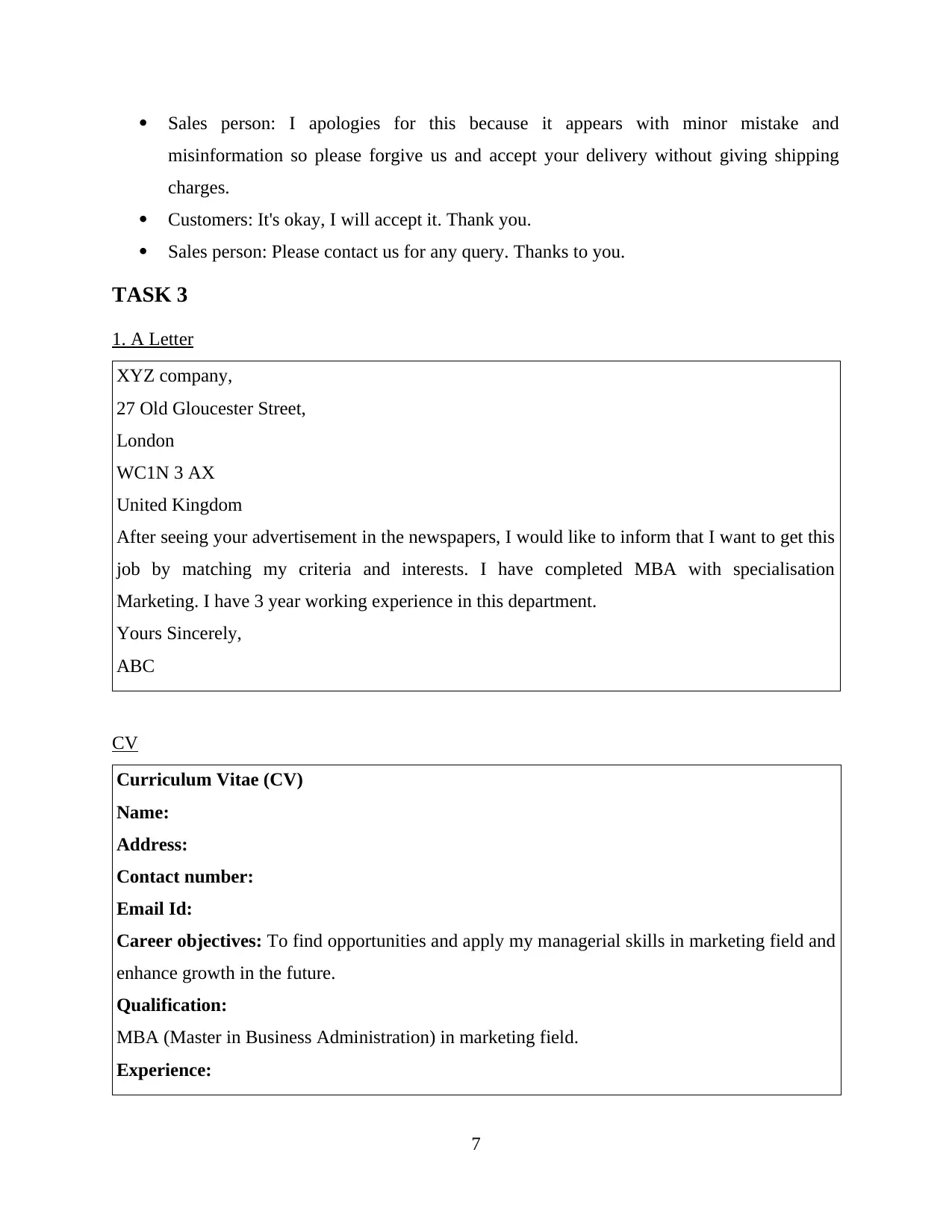
Sales person: I apologies for this because it appears with minor mistake and
misinformation so please forgive us and accept your delivery without giving shipping
charges.
Customers: It's okay, I will accept it. Thank you.
Sales person: Please contact us for any query. Thanks to you.
TASK 3
1. A Letter
XYZ company,
27 Old Gloucester Street,
London
WC1N 3 AX
United Kingdom
After seeing your advertisement in the newspapers, I would like to inform that I want to get this
job by matching my criteria and interests. I have completed MBA with specialisation
Marketing. I have 3 year working experience in this department.
Yours Sincerely,
ABC
CV
Curriculum Vitae (CV)
Name:
Address:
Contact number:
Email Id:
Career objectives: To find opportunities and apply my managerial skills in marketing field and
enhance growth in the future.
Qualification:
MBA (Master in Business Administration) in marketing field.
Experience:
7
misinformation so please forgive us and accept your delivery without giving shipping
charges.
Customers: It's okay, I will accept it. Thank you.
Sales person: Please contact us for any query. Thanks to you.
TASK 3
1. A Letter
XYZ company,
27 Old Gloucester Street,
London
WC1N 3 AX
United Kingdom
After seeing your advertisement in the newspapers, I would like to inform that I want to get this
job by matching my criteria and interests. I have completed MBA with specialisation
Marketing. I have 3 year working experience in this department.
Yours Sincerely,
ABC
CV
Curriculum Vitae (CV)
Name:
Address:
Contact number:
Email Id:
Career objectives: To find opportunities and apply my managerial skills in marketing field and
enhance growth in the future.
Qualification:
MBA (Master in Business Administration) in marketing field.
Experience:
7
⊘ This is a preview!⊘
Do you want full access?
Subscribe today to unlock all pages.

Trusted by 1+ million students worldwide
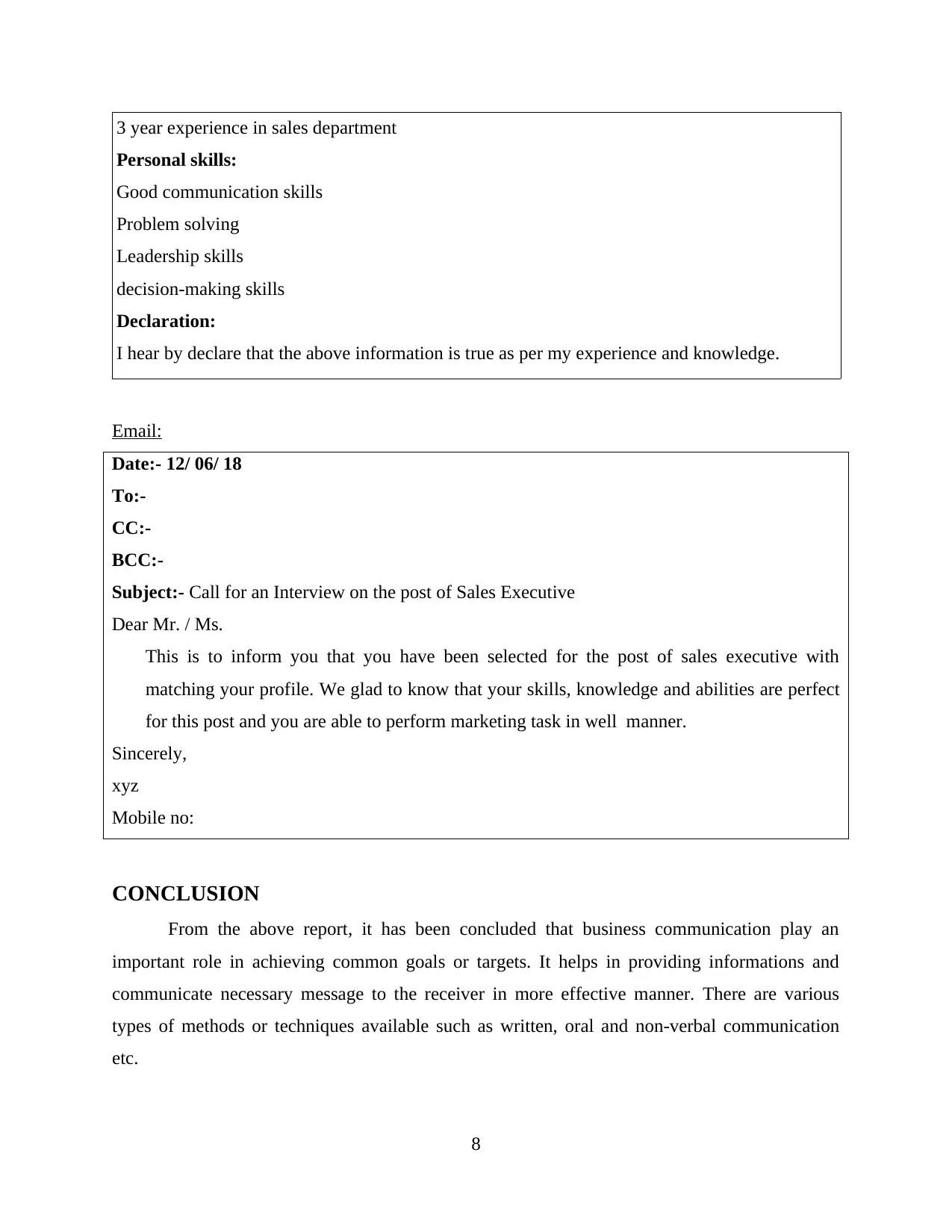
3 year experience in sales department
Personal skills:
Good communication skills
Problem solving
Leadership skills
decision-making skills
Declaration:
I hear by declare that the above information is true as per my experience and knowledge.
Email:
Date:- 12/ 06/ 18
To:-
CC:-
BCC:-
Subject:- Call for an Interview on the post of Sales Executive
Dear Mr. / Ms.
This is to inform you that you have been selected for the post of sales executive with
matching your profile. We glad to know that your skills, knowledge and abilities are perfect
for this post and you are able to perform marketing task in well manner.
Sincerely,
xyz
Mobile no:
CONCLUSION
From the above report, it has been concluded that business communication play an
important role in achieving common goals or targets. It helps in providing informations and
communicate necessary message to the receiver in more effective manner. There are various
types of methods or techniques available such as written, oral and non-verbal communication
etc.
8
Personal skills:
Good communication skills
Problem solving
Leadership skills
decision-making skills
Declaration:
I hear by declare that the above information is true as per my experience and knowledge.
Email:
Date:- 12/ 06/ 18
To:-
CC:-
BCC:-
Subject:- Call for an Interview on the post of Sales Executive
Dear Mr. / Ms.
This is to inform you that you have been selected for the post of sales executive with
matching your profile. We glad to know that your skills, knowledge and abilities are perfect
for this post and you are able to perform marketing task in well manner.
Sincerely,
xyz
Mobile no:
CONCLUSION
From the above report, it has been concluded that business communication play an
important role in achieving common goals or targets. It helps in providing informations and
communicate necessary message to the receiver in more effective manner. There are various
types of methods or techniques available such as written, oral and non-verbal communication
etc.
8
Paraphrase This Document
Need a fresh take? Get an instant paraphrase of this document with our AI Paraphraser
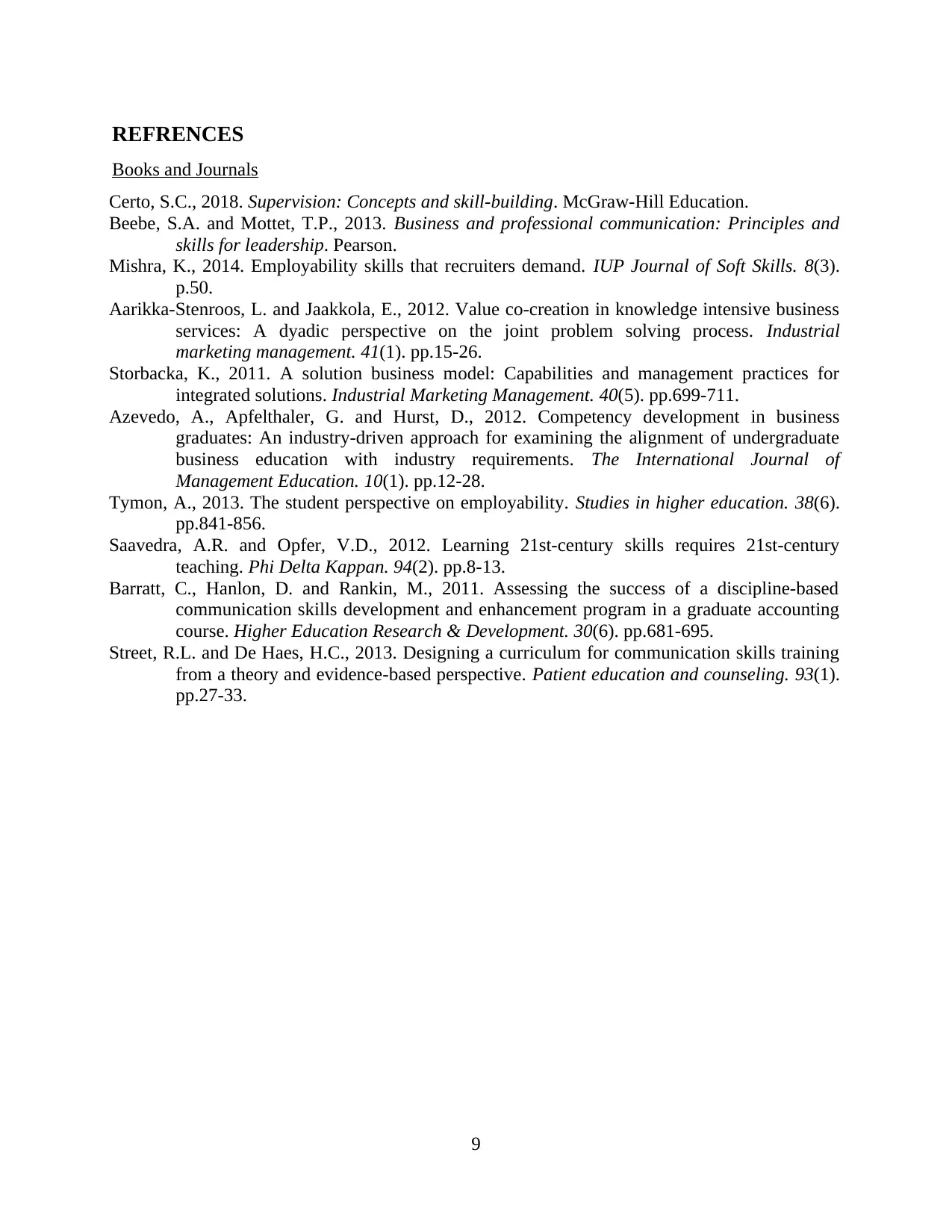
REFRENCES
Books and Journals
Certo, S.C., 2018. Supervision: Concepts and skill-building. McGraw-Hill Education.
Beebe, S.A. and Mottet, T.P., 2013. Business and professional communication: Principles and
skills for leadership. Pearson.
Mishra, K., 2014. Employability skills that recruiters demand. IUP Journal of Soft Skills. 8(3).
p.50.
Aarikka-Stenroos, L. and Jaakkola, E., 2012. Value co-creation in knowledge intensive business
services: A dyadic perspective on the joint problem solving process. Industrial
marketing management. 41(1). pp.15-26.
Storbacka, K., 2011. A solution business model: Capabilities and management practices for
integrated solutions. Industrial Marketing Management. 40(5). pp.699-711.
Azevedo, A., Apfelthaler, G. and Hurst, D., 2012. Competency development in business
graduates: An industry-driven approach for examining the alignment of undergraduate
business education with industry requirements. The International Journal of
Management Education. 10(1). pp.12-28.
Tymon, A., 2013. The student perspective on employability. Studies in higher education. 38(6).
pp.841-856.
Saavedra, A.R. and Opfer, V.D., 2012. Learning 21st-century skills requires 21st-century
teaching. Phi Delta Kappan. 94(2). pp.8-13.
Barratt, C., Hanlon, D. and Rankin, M., 2011. Assessing the success of a discipline-based
communication skills development and enhancement program in a graduate accounting
course. Higher Education Research & Development. 30(6). pp.681-695.
Street, R.L. and De Haes, H.C., 2013. Designing a curriculum for communication skills training
from a theory and evidence-based perspective. Patient education and counseling. 93(1).
pp.27-33.
9
Books and Journals
Certo, S.C., 2018. Supervision: Concepts and skill-building. McGraw-Hill Education.
Beebe, S.A. and Mottet, T.P., 2013. Business and professional communication: Principles and
skills for leadership. Pearson.
Mishra, K., 2014. Employability skills that recruiters demand. IUP Journal of Soft Skills. 8(3).
p.50.
Aarikka-Stenroos, L. and Jaakkola, E., 2012. Value co-creation in knowledge intensive business
services: A dyadic perspective on the joint problem solving process. Industrial
marketing management. 41(1). pp.15-26.
Storbacka, K., 2011. A solution business model: Capabilities and management practices for
integrated solutions. Industrial Marketing Management. 40(5). pp.699-711.
Azevedo, A., Apfelthaler, G. and Hurst, D., 2012. Competency development in business
graduates: An industry-driven approach for examining the alignment of undergraduate
business education with industry requirements. The International Journal of
Management Education. 10(1). pp.12-28.
Tymon, A., 2013. The student perspective on employability. Studies in higher education. 38(6).
pp.841-856.
Saavedra, A.R. and Opfer, V.D., 2012. Learning 21st-century skills requires 21st-century
teaching. Phi Delta Kappan. 94(2). pp.8-13.
Barratt, C., Hanlon, D. and Rankin, M., 2011. Assessing the success of a discipline-based
communication skills development and enhancement program in a graduate accounting
course. Higher Education Research & Development. 30(6). pp.681-695.
Street, R.L. and De Haes, H.C., 2013. Designing a curriculum for communication skills training
from a theory and evidence-based perspective. Patient education and counseling. 93(1).
pp.27-33.
9
1 out of 11
Related Documents
Your All-in-One AI-Powered Toolkit for Academic Success.
+13062052269
info@desklib.com
Available 24*7 on WhatsApp / Email
![[object Object]](/_next/static/media/star-bottom.7253800d.svg)
Unlock your academic potential
Copyright © 2020–2025 A2Z Services. All Rights Reserved. Developed and managed by ZUCOL.





